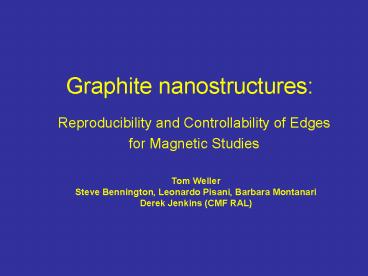Graphite nanostructures: PowerPoint PPT Presentation
1 / 23
Title: Graphite nanostructures:
1
Graphite nanostructures
- Reproducibility and Controllability of Edges
- for Magnetic Studies
Tom Weller Steve Bennington, Leonardo Pisani,
Barbara Montanari Derek Jenkins (CMF RAL)
2
Ribbons and defects theoretically implicated in
carbon magnetism
- Zigzag edges
- Pores
- Defect structures
- Ribbons of width lt2nm
- Etc
3
Aim
- Remove Experimental Ambiguity
- Understand and Control Samples
- Samples with lots of one type of defect/edge.
- Enough for neutrons?
- Attempt to approach theoretically interesting 2nm
wide ribbons. - Measure magnetoresistance as a function of
defects, width, etc. utilising body of work
building on graphite/graphene, but not with
defects etc.
4
TOP DOWN
Graphene device 200nm wide Novoselov et al.
Bilayer graphene device 1000nm wide Novoselov et
al.
Graphene device 6Å deep, 4000nm wide Morosov et
al.
Graphite device, 35 layers, 2000nm wide Zhang et
al.
Graphene device 1000nm wide Zhang et al.
5
Graphene dot 10nm diameter using nanodiamond
particles deposited on HOPG by electrophoresis
and then heat treated at 1600 Enoki et al.
1-13 graphene layers, 400µm wide, epitaxially
grown from 6H-SiC (0001) by laser ablation or
1400 treatment Ohkawara et al. Berger et al.
BOTTOM UP
6
Scotch Tape structures
450 nm
0.3nm
7
250 nm
100nm
0.3nm
0.3nm
0.6nm
8
0.3nm
9
Problems with Scotch Tape Structures
- Too wide
- No reproduceability
- Need to control cutting
- If we can control cutting then maybe we can cut
along a specific direction in the ab-plane to
achieve a controllable population of edge types
10
Standard Lithography
- Prepare pattern
- Prepare substrate
- Drop on SU8 of concentration/viscosity
- Spin to give thin layer
- Bake to remove solvent
- Crosslink pattern with electron beam
- Develop with SU8 developer
- Rinse with Isopropanol
- Etch
11
Pattern to Write on SU8
- Pattern diagram AutoCAD
- Dose array 9 identical patterns at 10, 20, 30,
40, 50, 60, 70, 80, 90µC/cm2. - Each pattern has
SU8 ebeamed where yellow, but within each bar
there are four bars of various widths 10nm,
50nm, 100nm, and 200nm
12
Direct ebeam on HOPG
1mm
Is the ebeam damage similar to the protons
electron release?
13
Pattern ebeamed onto SU8 on HOPG Substrate seen
with
Optical Microscope
14
SU8 pattern underexposed
15
Si rules of thumb not valid,Si backscattering
much greater than HOPG backscattering
So new dosage information must be gathered
16
But
- Does this mean with HOPG substrate we can achieve
higher resolution in feature size? - We must find the correct dosages.
17
Oxygen Etched HOPG Structures
Ruoff et al. specific plasma parameters in
Electron Cyclotron Resonance etcher, we have
Inductively Coupled Plasma etcher
18
Oxygen etching can produce graphene nanoribbons
What causes these to form does this come from is
what we want to answer?
19
Pardo et al.
- Large pore-size dispersion
- 10 - 2000 nm diameter
ZOOM
- Small pore-size dispersion
- 10 20 nm diameter
- Expect variable pore size
- with etch parameters
20
2002
1992
1992
21
Pyrolisation of SU8
- Potentially smaller features due to volume loss.
- Few previous studies, and they lack structural
detail, so useful work. Additionally Building up
to electrospinning requirement of width for
edges to be significant portion, needs 3nm
diameter. - 1st Pyrolise SU8 powder.
- 2nd Pyrolise SU8 spun coating more orientation?
Bilenberg 2006
22
- We will study magnetoresistance as a function of
width and defects on the structures we synthesis
using the lithography techniques we will develop. - This requires synthesis technique development.
23
- We will try to produce graphite
- nanostructures from SU8, this will free us
- from the HOPG substrate
- there may be other ways...

